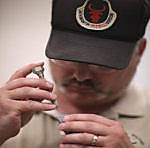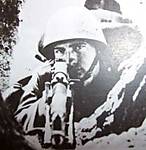Quoted Text
You are holding everyone else to a standard of research you yourself are unwilling to meet.
Not at all, I have provided several references from just doing a few minutes of Internet research. No big deal, but more than others are providing. Almost all of your post is just your opinion.
Quoted Text
When you produce that evidence you can demand evidence from everyone else.
I have cited several references to the problems of rail gauges, and I invite you to
look here, which shows the Polish rail system as destroyed by the retreating Germans and not rebuilt until after the war. That unfortunately doesn't prove the Russians didn't repair the lines, but it casts into doubt they had rail heads within easy striking distance of Berlin. Also look
here, where it says the destruction of the Polish railway system was at 84%. The Russians were in a hurry to get to Berlin before the Americans and British, and were eager to end the war. It's just as easy to argue that they drove their replacement tanks there.
I'm far from an expert in this, but I'm satisfied I have produced evidence that does not support the notion of the Soviets extending the railheads close to Berlin.
Quoted Text
Remember absence of evidence is not evidence of absence, so even if no one can produce a photo or other records of Soviet tanks on trains, that doesn't mean it wasn't done.
We don't need a photo, but no one has even offered a text reference. Y'all are simply convinced it's so. I will leave you to your convictions, as this discussion is becoming more theological than actual.
Quoted Text
As it happens these photos are abundant.
Then please show some of tanks being shipped outside the Soviet Union. I am sure the Russians were shipping tanks and everything else
within territory they controlled, and I have no doubt they performed yeoman work in repairing
their own rail net. But neither you nor anyone else who believes in entrained T-34s dropped off in Oranienburg or Potsdam has been able to cite any evidence that the rail net was extended even to Warsaw.
Quoted Text
I wrote that rail repair is fast work, and it is. If you'd like evidence, look at US strategic bombing and their BDAs. Whenever they bombed German rail lines or even marshalling yards, the repairs were very quickly done.
There is a BIG difference between repairing a bombed-out rail line and replacing 100s of kilometers of ripped-up tracks. And no one has addressed the question of what the Russians would have moved over these tracks, since the Polish gauges are narrower than the Russian ones. Please explain that.
Quoted Text
3. Another way you can check this is to look up some stats on road marches. It was simply not feasible in a WW2 tank battalion to drive tanks around for hundreds of miles day after day.
And so you're claiming (since it's just a claim) that when the Russian advance on Berlin quickly moved several hundred miles from the Vistula in January to the Oder in February that the Russians sat around waiting for the rail repair battalions to fix the lines, provide non-existent locos and rolling stock, and THEN ship replacement tanks to the front?
Quoted Text
4. The Red Army had a grand total of a couple dozen transporter trucks during WW2 so they had to have moved their tanks long distances by rail.
Yes, and the North Vietnamese had very few trucks to go down the Ho Chi Minh Trail, but they somehow managed to get their supplies to the South.
Quoted Text
The original question was why all their tanks seem to be banged up in the fenders. Following Occam's Razor (the simplest explanation that works is probably right) I imagine the answer has nothing to do with any of this esoteric stuff. It is probably closely related to the fact that Red Army drivers were often very poorly trained, their tanks were hard to steer, they probably had pretty cheap fenders, the vision devices weren't the best, and they didn't care if they banged into things as long as they lived through that particular day.
And this is exactly the kind of wool-gathering that I prefer to avoid in discussing historical matters. Maybe they were all drunk on Vodka? Or perhaps their officers gave them extra rations if they smashed through German buildings?
I think your arguments need a shave, as they're quite hairy.




































